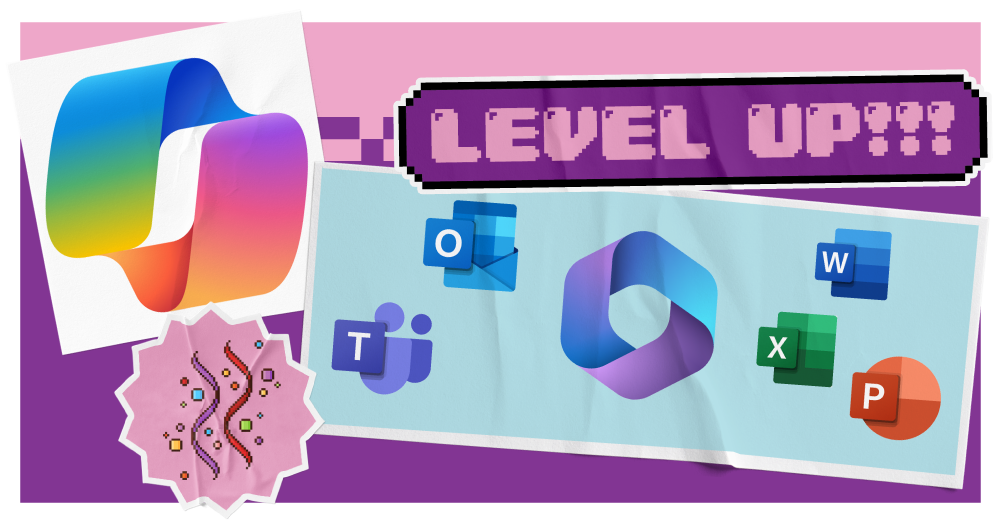The explosion of AI shows no signs of stopping. And Microsoft are fuelling the flames by bringing brand new features to Copilot.
Their latest wave release has announced innovative functionality coming to the AI assistant between October 2024 and March 2025.
Highlights include collaborative prompting, the introduction of Copilot agents and advanced integration with your existing Microsoft tools.
In the video below, our Chief Innovation Officer, Tristan Shortland, explains all the key announcements you need to be aware of:
Or keep reading to see more detail about Copilot’s incoming features!
What new Copilot features are coming?
Collaborative prompting with Copilot Pages
One of the most significant updates is a new interface called Copilot pages. This is already generally available for users with a Microsoft 365 Copilot licence.
Copilot Pages is a blank canvas where multiple people can collaborate using AI. Previously, a conversation with Copilot is held within that specific timeframe. If you go away and come back, you need to start from scratch.
But with Copilot pages, AI-generated output is stored. You can continue to work away at a problem or a piece of content, adding information and asking more questions over time.
You can also introduce colleagues into the canvas, where they can add their thoughts in real-time, using AI assistance. It creates a collaborative process, where AI works as another member of the team.
Copilot in Excel
Copilot is now generally available in Excel for anyone with a Microsoft 365 licence, with some recent enhancements.
You can do use Copilot for a range of tasks, including X look ups and conditional formatting within the spreadsheet you are working on. It can help you understand and visualise data, undertake what-if analysis and predict outcomes.
Microsoft have also added the ability to use Python with Copilot in Excel. So, one of the world’s most popular programming languages can now work with our data, using natural language prompts in Excel. This supports with advanced analytics, forecasting, risk analysis and visualising more complex data, without needing to understand or write the Python code yourself.
Copilot in PowerPoint
New capability is also coming to PowerPoint!
This includes the narrative builder, which is already generally available. It allows you to use Copilot to build a first draft presentation, which you can then refine through prompts. This includes adding topics, changing orders or reformatting your deck.
As with everything in Copilot, this is achieved through natural language inputs.
Also coming soon is the brand manager. This offers the ability to look at your company’s centralised branding and utilise that when creating a deck in PowerPoint. It ensures consistency across the business against your brand that will have already been verified by marketing branding team. It can also pull in approved assets for images, format and so on.
Copilot in Teams
New features are coming to Copilot in Teams, building on the previously available AI transcription feature.
Copilot can now use data from the meeting chat, including questions asked. This enables Copilot to give better meeting context and answer specific questions about actions.
This feature is already available in your Microsoft 365 Copilot licence.
Copilot in Outlook
Copilot will soon do more in your Outlook inbox.
One feature coming for public preview in late 2024 is the ability to prioritise your inbox. Copilot can highlight particularly important messages, such as from prioritised people or using specific keywords. If you’ve got a lot of emails, you can quickly identify what’s important and summarise long chains.
Copilot in Word
Copilot can also now do more in Word.
Already publicly available, Copilot and Word work together to reference web data, and data from Word, PowerPoint, PDFs, emails and meetings. This makes it easier to pull information together, and then use Copilot to refine it into a legible, well-structured document.
Copilot Agents
Here is one of the updates we’re most excited for: Copilot Agents! These were already available in Copilot Studio, but now are available in Microsoft 365 too.
For a long time, Copilot has had the ability to answer questions using its large language model. But now, it can perform actions too. Examples include logging a ticket in a ticketing system or raising a change in an HR system.
This takes Copilot to a whole new ability, with the potential to gain greater time savings and automate manual processes.
You can preview how this works in SharePoint in the video below:
Get Copilot-ready with Infinity Group
Copilot has been a marketing leading AI tool for some time, but these features drive it to the next level. Using it, your teams can win substantial productivity benefits and do more in the Microsoft tools you already use.
If you want to find out more about Copilot and how it can support your business, our ’45 ways to use Copilot’ guide will give you tasks to test out across your core departments.
Plus, you can find out how Copilot helped us save 2000 hours per year with our very own case study.

